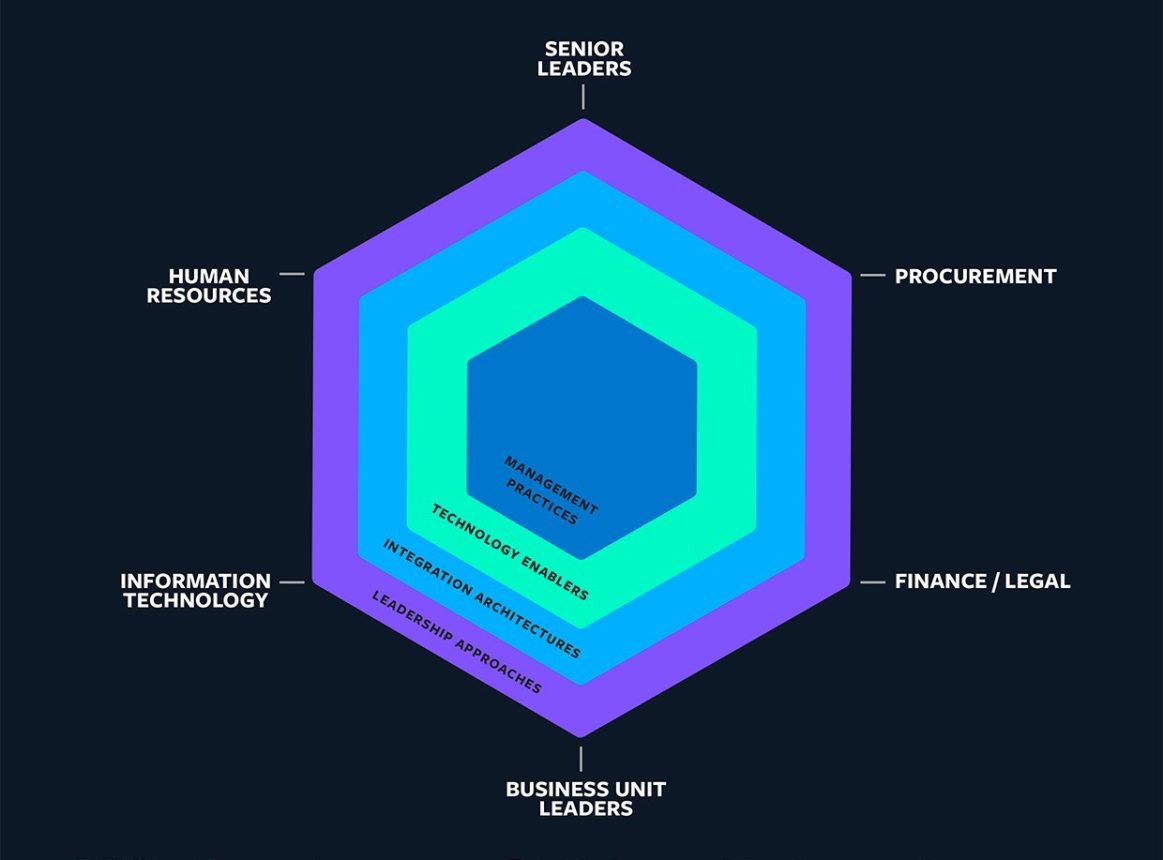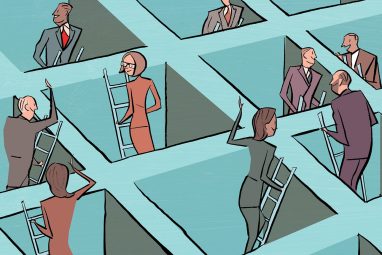Workforce Ecosystem Orchestration: A Strategic Framework
New research suggests that taking a holistic approach to strategically managing all contributors in the workforce ecosystem can enable enterprise success.
Topics
News
- Gulf Nations Fast-Track AI Ambitions, UAE Leads Regional Readiness, says BCG Report
- AI Professionals form a Redefined Workforce. But Systemic Roadblocks Persist, Survey Finds
- AI-Driven Scams Surge as Microsoft Blocks $4 Billion in Fraud Attempts
- Identity-based Attacks Account for 60% of Leading Cyber Threats, Report Finds
- CERN and Pure Storage Partner to Power Data Innovation in High-Energy Physics
- CyberArk Launches New Machine Identity Security Platform to Protect Cloud Workloads

As organizations increasingly rely on contributors beyond their own employees, the once simple question of who (or what) is doing the work now has far-reaching implications for management practices, leadership approaches, and what it means to be a socially responsible business.
Our research shows, for example, that corporate diversity, equity, and inclusion practices (and goals) are typically internally focused and do not encompass external contributors. And yet more than 90% of respondents to our global executive survey agree that their workforce includes external contributors. Many organizations rely on external contributors to perform at least 30% of the work, yet accessing and engaging with talent is often siloed, fragmented, and uncoordinated across internal and external contributors. We have seen organization after organization realize, belatedly, that their dependence on external workers was creating inefficiencies and missed strategic opportunities.
Taking a workforce ecosystems perspective — which we detail below — helps leaders think more broadly and holistically about their workforce. This approach recognizes that the composition and boundaries of the workforce have changed; long- and short-term contractors, gig workers, partners, and technologies can all be part of a workforce. Workforce ecosystems embrace the idea that contributions to performance outcomes, irrespective of employment status, determine whether a person, partner, or technology is part of an organization’s overall workforce.
A workforce ecosystem is a structure focused on value creation for an organization that encompasses actors, from within the organization and beyond, working to pursue both individual and collective goals, and that includes interdependencies and complementarities among the participants.
New functional relationships and leadership approaches are often necessary to effectively orchestrate workforce ecosystems. It is common for procurement, IT, marketing, a business unit, or another group to contract with external contributors while HR ensures that employees have the appropriate skills and recognition opportunities. In effective workforce ecosystems, these groups are more likely to be working together to supply both internal and external workers; develop diverse, inclusive, and equitable cultures; measure worker productivity; and create accessible learning and development opportunities.
Virtually all of the leaders we have interviewed agree that leading teams that include external contributors who may have more autonomy and flexibility than employees is both a challenge and an opportunity. A traditional, hierarchical command-and-control leadership approach is far less (or not at all) effective in networked, boundary-spanning structures like workforce ecosystems. At the same time, many leaders now view their corporate purpose and social responsibilities as being inclusive of external contributors — a far more expansive view than they had in the past, when they relied less on these workers.
New functional relationships and leadership approaches are often necessary to effectively orchestrate workforce ecosystems.
Companies’ relative lack of control over external contributors does not make them exempt from engaging responsibly with such workers, especially given that contingent workers are five times more likely than employees to be let go during a downturn. A growing number of workers are in precarious work arrangements that are low paid, insecure, unprotected, and insufficient to support a household. The increasing prevalence of workforce ecosystems has the potential to increase or decrease the economic and social security of many workers. Getting workforce ecosystems right — for all workforce contributors — is both a business imperative and a social responsibility.
The Workforce Ecosystem Orchestration Framework
Based on three years of research involving over 50 individual executive interviews and multiple global cross-industry surveys that yielded more than 13,000 responses, we developed a framework to help leaders manage — or orchestrate — workforce ecosystems. The figure below provides a graphical representation of the framework, with hexagons representing key themes and axes linking critical stakeholders.
A Framework for Workforce Ecosystem Orchestration

Leaders can consider various functional groups and actions as they strive to manage all contributors in a more holistic fashion.
The notion of orchestration, or bringing together disparate elements in a harmonious way, provides a valuable analogy for leaders working in concert to coordinate members of a workforce ecosystem. Beyond traditional management, which generally implies exerting control, orchestrating reflects that while contributors have their own agency or autonomy, an organization can intentionally coordinate participants in an effort aligned toward reaching individual and shared strategic and operational objectives.
This framework brings together four themes for orchestrating workforce ecosystems: (1) management practices, (2) technology enablers, (3) integration architectures, and (4) leadership approaches. Each is represented by one of the concentric hexagons in the figure. The figure also includes three axes — one vertical and two horizontal — connecting a selection of stakeholders that play key roles in workforce ecosystem orchestration.
Shifting Management Practices
As organizations transition to intentionally orchestrating workforce ecosystems, many previously effective management practices need to shift to accommodate new organizational structures. While some of these changes are centered in HR, such as compensation, benefits, performance management, and so on, many others are spread across functions spanning organizational boundaries. For example, strategic planning and sales development may change with new connections to external contributors.
External workers produce at least 30% of the work in roughly half of the organizations we surveyed in 2022. In some sectors, like the tech industry, it’s not uncommon for contingent workers to account for 40% to 50% of an organization’s workforce. When the composition and boundaries of the workforce shift, leaders tend to reconsider their focus on, and dedication to, the widely accepted but increasingly outdated employee life cycle model of attracting, developing, and retaining employees. This model assumes that the predominant, and most important, contributors to an organization are employees, and it omits what organizations increasingly depend on to meet their objectives: contingent workers and other partners.
Organizations need a more flexible approach to finding and engaging a wide range of workers. The emergence of new employment and engagement models are enabling organizations to find workers they need, when they need them, for as long they’re needed, and wherever they are needed. As a result, organizations are changing how they access talent. One trend is to shift from a job-based model to one that is skills-based. It is no surprise that companies are increasing their dependence on labor platforms and employment agencies, such as Toptal, Manpower, and Randstad Sourceright, which use technology to match organizational needs with worker skills.
At the same time, workers want more flexibility in their work arrangements. Employees may want the opportunity to move around the organization, to develop new skills, and to work with different teams and functions. External contributors may want the opportunity to choose which projects to work on, which employers to work with, and when they want to work. As individuals think differently about how to spend their working years — which may be decades longer as life spans lengthen — workers are changing how they plan and manage their careers. Management practices within workforce ecosystems need to accommodate and address flexibility objectives for both individuals and companies.
Technology Enablers With Workforce Ecosystems
There is a wide range of technologies shaping, supporting, and also participating in workforce ecosystems. In many cases, however, existing technologies are disconnected, incompatible, and insufficient for connecting internal and external contributors. Several managers we interviewed explained their vision for linking distinct worker groups only to lament that they cannot do so because systems don’t yet exist at scale to accomplish what they need. One manager bemoaned the fact that his team has broken every system that it has tried. Similar to the technologies behind other digital transformation challenges, data and information systems for an extended workforce are not yet capable of fully supporting needed organizational change. In some cases, organizations are working to knit together systems from multiple vendors. In others, they are taking a phased approach by initially deploying systems that solve subsets of the problem (such as an internal talent marketplace that doesn’t yet incorporate external workers) and working concurrently to envision new systems to support more integrated organizational structures.
Navigating the sheer variety of technologies that exist or are in development to support workforce ecosystems is a challenge. We sort this collection into five categories: (1) work tech, (2) workforce tech, (3) workplace tech, (4) credentialization and verification tech, and (5) technology as a participant in a workforce ecosystem.
Work tech encompasses tools to assist with productivity, augmentation, and collaboration. They include spreadsheets, word processors, medical diagnostic tools, navigation systems, and other technologies people use to do work. Whether a worker is an employee or external contributor, they will likely use some form of work tech to accomplish their tasks. Acquiring, licensing, and maintaining these technologies poses complex challenges when workers are not all employed by the same organization.
Workforce tech includes technologies that organizations use to manage workforces and that workers use to access opportunities. These systems have traditionally been used to manage internal workers but, more recently, have been expanding to address external contributors as well. Their sophistication is rapidly increasing as they incorporate data on mobility, skills, capabilities, growth opportunities, mentoring, networking, and so on.
Workplace tech covers the communication tools that became popular during the COVID-19 pandemic, such as Zoom and Slack. These technologies have existed for some time but, initially, tended to be cumbersome to deploy and use. In recent years, they have become much more accessible and are making it easier to connect people who may not all work for the same organization.
Credentialization and verification tech refers to technologies that allow organizations and individuals to issue, store, share, and verify credentials. With workers moving between organizations and roles more frequently, these tools are playing a key role in enabling workforce ecosystems. Blockchain technologies, for example, ensure that data is verifiable, fast, portable, and reliable as workers move not only between organizations but also among workforce ecosystems.
Technology as a participant in a workforce ecosystem includes automation and technologies to accomplish work either alone or in conjunction with humans. Robotic process automation, software chatbots, systems powered by AI and machine learning, and other technologies fall into this category. Workforce ecosystems provide a structure to consider these technologies along with human counterparts as they all contribute to strategic organizational goals.
These categories together organize technologies that leaders are harnessing as they orchestrate workforce ecosystems. Each category includes its own set of opportunities, challenges, and risks, and in combination they provide engines that enable the rapid growth of workforce ecosystems.
Integration Architectures for Workforce Ecosystems
Workforce ecosystems are complex: They include individuals, organizations, and technologies; span internal functions and business units; and encompass relationships that are both long term (possibly lasting decades) and short term (potentially lasting hours or even just minutes). An overriding question for leaders orchestrating workforce ecosystems is how to design them and coordinate all of the elements so they can be most effective: To what extent do leaders want their workforce ecosystems to be tightly coordinated with strict governing rules, and, more importantly, how do they want to accomplish the ecosystem integration?
Leaders face two types of integration challenges in workforce ecosystems. First, within an organization, how should disparate groups (functions or departments) be integrated as they manage an extended workforce including external contributors? And second, how should the organization at the center of the workforce ecosystem interact with ecosystem members? The first question addresses internal integration architectures, while the second addresses external relationships. In our workforce ecosystem orchestration framework, the Integration Architectures hexagon represents both questions.
Internal integration architectures may be more or less centralized. In centralized integration architectures, powerful steering committees with cross-functional representation coordinate workforce planning and the management of both internal and external workers.
In decentralized models, managers have broad discretion to access and engage external contributors. An IT department that needs resources can build relationships with IT vendors and contract with them for however many workers it needs for however long it needs them, as long as it complies with internal guidelines. Or a marketing department can bring in experts like digital marketers to fill specific project gaps. In these cases, senior managers may not have visibility into all of the external engagements occurring across their organizations. And although this is currently the most common approach to external workforce engagement and provides maximum flexibility, it comes with substantial drawbacks in terms of coordination and efficiency. What’s more, attention to equitable pay can easily vary in decentralized models, especially across geographies where political and regulatory systems differ. More broadly, organizations using a decentralized model are less likely to consistently apply diversity, equity, and inclusion policies to external contributors.
The second question addresses relationships with external parties, such as app developers whose products complement those of another organization. Companies may take different approaches to this community. For instance, Apple imposes far more constraints on app developers than Google’s Android division does. A company’s decisions around its relationships with external contributors inform the integration architecture of its workforce ecosystem. These relationships may be more transaction-focused or relationship-oriented, they may be more or less regulated, and they may be more or less strategic for the business.
Leadership Approaches in Workforce Ecosystems
In our framework, leaders adopt new mindsets, behaviors, and tools to orchestrate actors within workforce ecosystems.
A recurring theme in our executive interviews is that leaders need to think differently about their roles. While resilience, courage, trust, and purpose are all popular areas of emphasis, the theme we hear most consistently involves relinquishing control. Without the customary tools of promotions (with new titles), raises, perks, and so on, leaders must reconsider their primary levers of influence over disparate groups that come together to accomplish specific objectives. While company employees customarily stay in roles for relatively long periods, have annual performance reviews, and receive annual raises, external contributors can move in and out of roles and projects as needs require.
While the idea of leading without authority is familiar, many leaders in workforce ecosystems increasingly recognize that this approach is a practical necessity to influence and persuade teams of internal and external participants. More and more, leaders are allowing, and even encouraging, employees to move into new internal roles to help them build their experiences and avoid losing them to outside opportunities. Orchestrating actors in a workforce ecosystem requires that leaders rapidly align disparate groups of contributors toward accomplishing clear missions and objectives.
Additionally, developing and sustaining an effective organizational culture that comprises internal and external workers can be a challenge — one that is complicated by having to manage hybrid workplaces, where some workers physically come into workplaces while others work remotely. To what extent should leaders try to build strong, consistent cultures when some participants are employees and others are not? Or where some workers are in the office and others are not? In organizations fueled by large communities of external contributors, for example, gig workers might not want to “belong” to a company’s corporate culture and might prefer a more transactional relationship with an organization. Building an appropriate culture for a diverse and interconnected workforce ecosystem that respects all participants is a critical leadership challenge.
Identifying and Organizing Key Stakeholders
This orchestration framework includes three axes that connect critical organizational roles that drive and enable workforce ecosystems. The vertical axis through the figure represents the role of senior and business unit leaders; the framework essentially revolves around these leaders because they play essential roles in orchestrating activities. The top horizontal axis connects HR and procurement, which have managerial responsibilities that require them to access, engage, and manage key contributors. The IT, finance, and legal teams represent functions that build and maintain processes that enable organizations to orchestrate workforce ecosystems. This figure does not explicitly encompass all critical organizational functions (such as R&D and marketing) but rather focuses on the groups our research has shown to be most directly involved with shifting from traditional, employee-centric, internally focused organizations to more open, networked, interdependent workforce ecosystems.
Workforce discussions often focus on how an organization can acquire and deploy the resources necessary to achieve strategic goals and objectives. With a workforce ecosystems approach, new strategic options become possible, and the process of discovering these options also changes. If top leaders are uncertain about how or whether to enter an emerging market because they lack crucial insights, for example, orchestrating a workforce ecosystem can help uncover those insights. If leaders want to build a strategy that relies on AI, for instance, but they worry about quickly acquiring the necessary scientists and data, workforce ecosystems can help make that strategy feasible.
By allowing organizations to more flexibly access a variety of contributors, workforce ecosystems enable new strategic avenues. As one executive told us, “True competitive differentiation comes from understanding the total workforce.” That understanding is not easily achieved. It requires transformational shifts in management practices, technology enablers, integration architectures, and leadership approaches.





